Abstract
Unilamellar liposomes of dipalmitoyl-phosphatidylcholine can incorporate various porphyrins in either the phospholipid bilayer or the internal aqueous compartment depending on the water-/lipo-solubility of the drug. Intraperitoneal injection of the liposome-bound porphyrins to mice bearing a MS-2 fibrosarcoma results in remarkably more efficient tumour targeting than that obtained by administration of the same porphyrins dissolved in homogeneous aqueous solution. Moreover, also water-insoluble porphyrins can be transported to the tumour via liposomes. Fractionation of liver and neoplastic cells indicates that the subcellular distribution of liposome-delivered porphyrins is also dependent on their solubility properties: thus, relatively polar porphyrins, such as tetra(4-sulfonatophenyl)porphine and uroporphyrin, are mainly recovered from the soluble fraction, whereas hydrophobic porphyrins, such as haematoporphyrin or porphyrin esters, preferentially partition in the cytoplasmic membrane. As a consequence, different subcellular sites can be targeted by porphyrins and possibly photodamaged through a suitable choice of the drug-carrier system.
Full text
PDF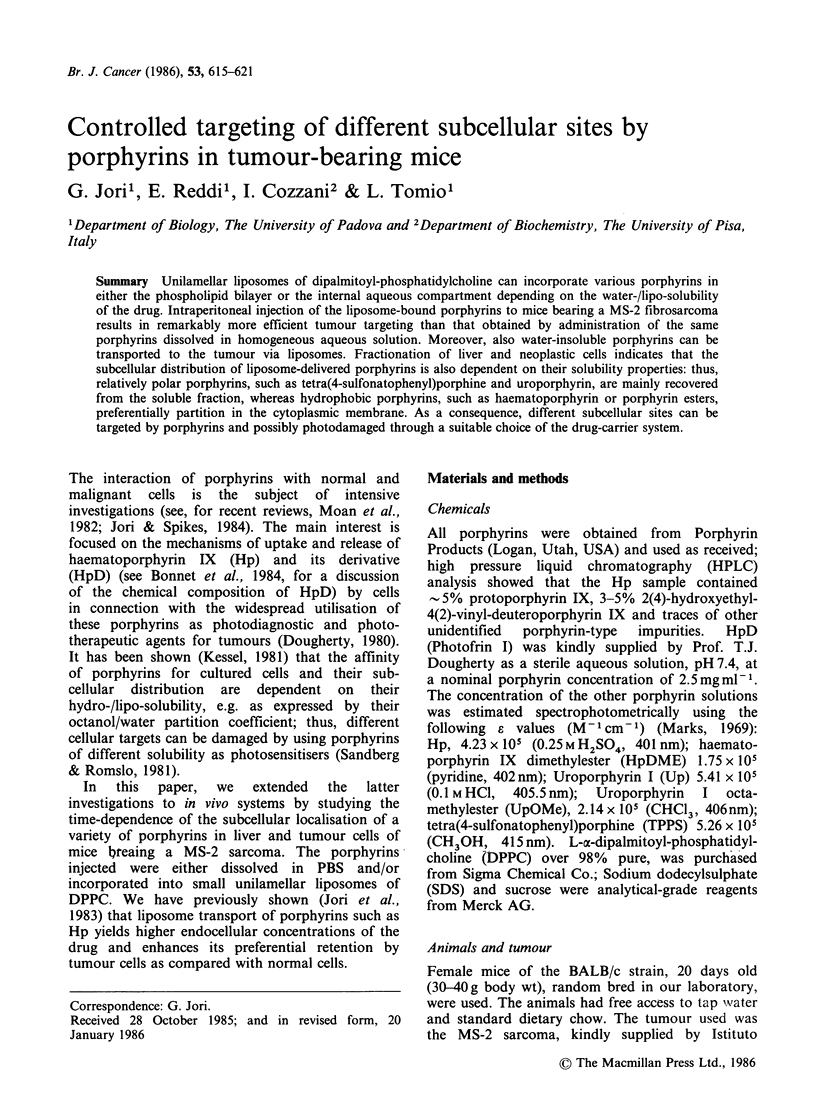
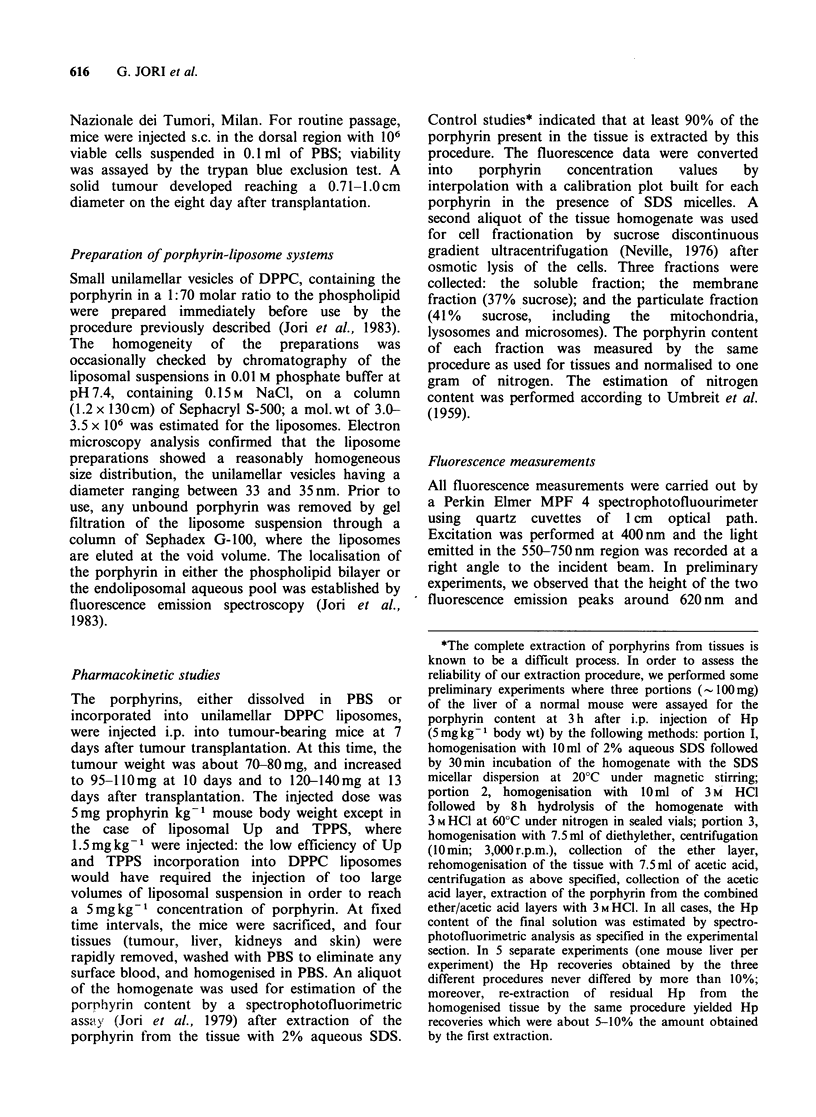
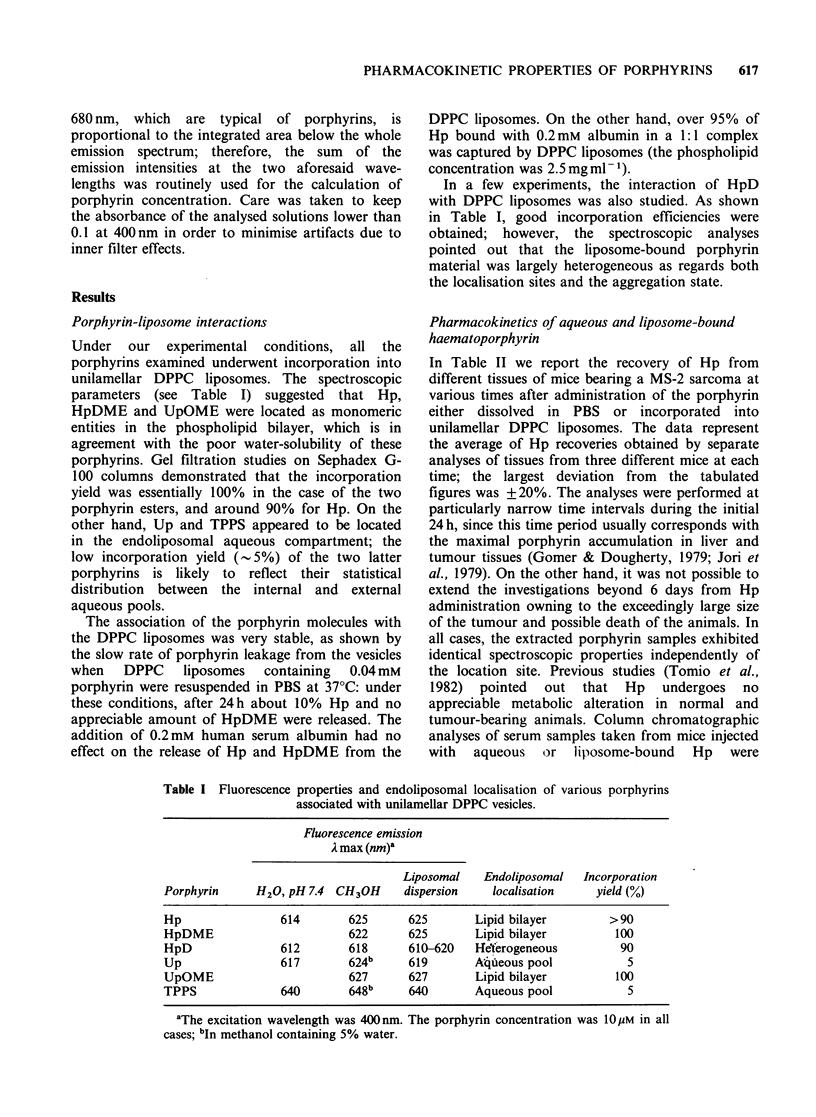
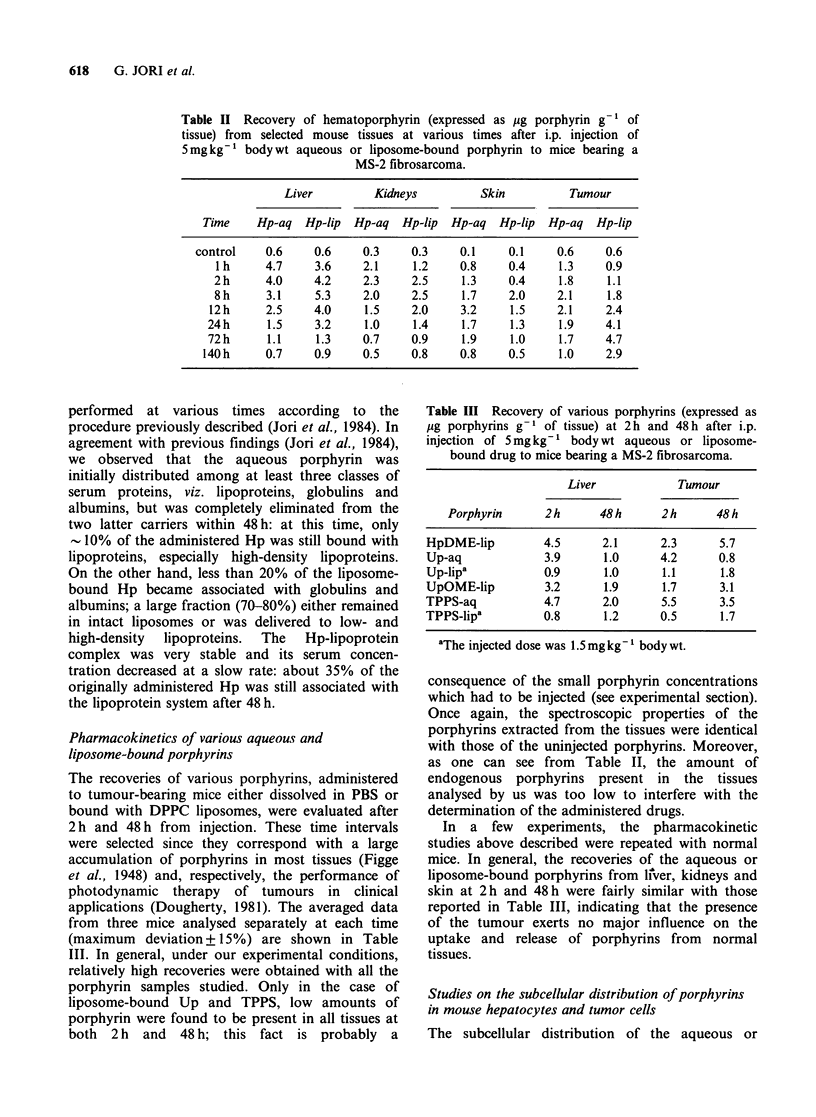

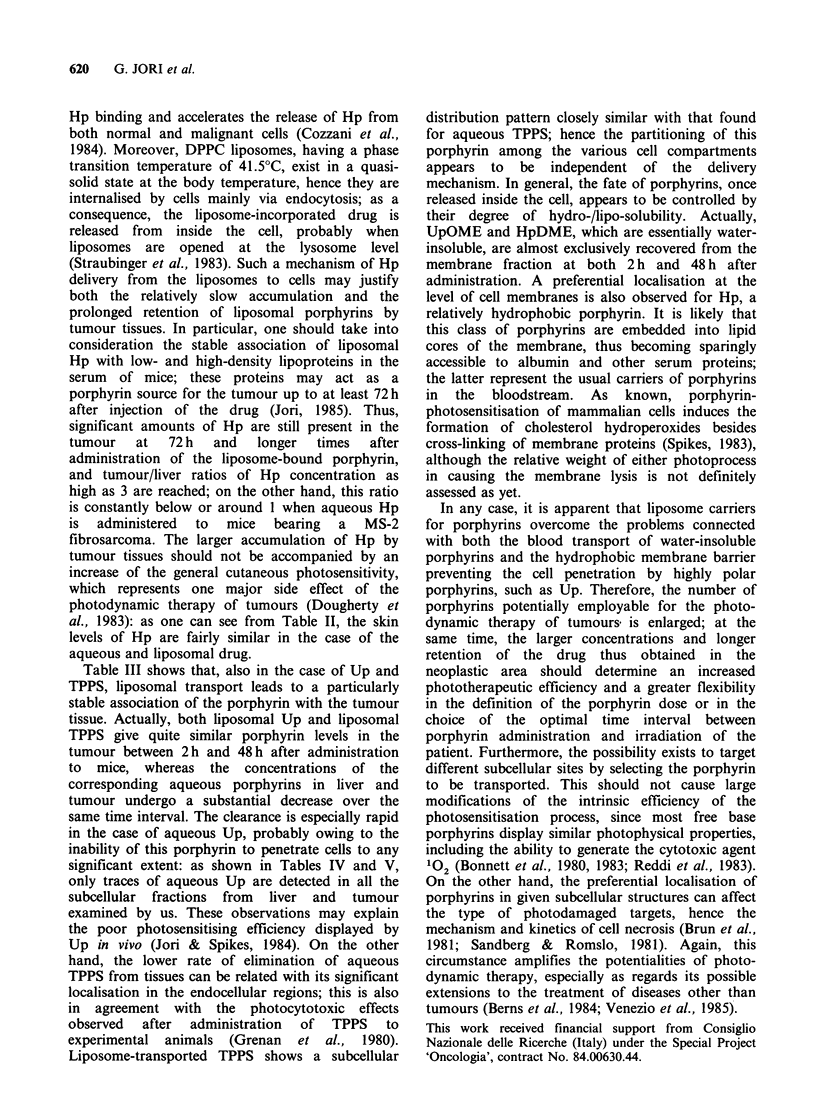
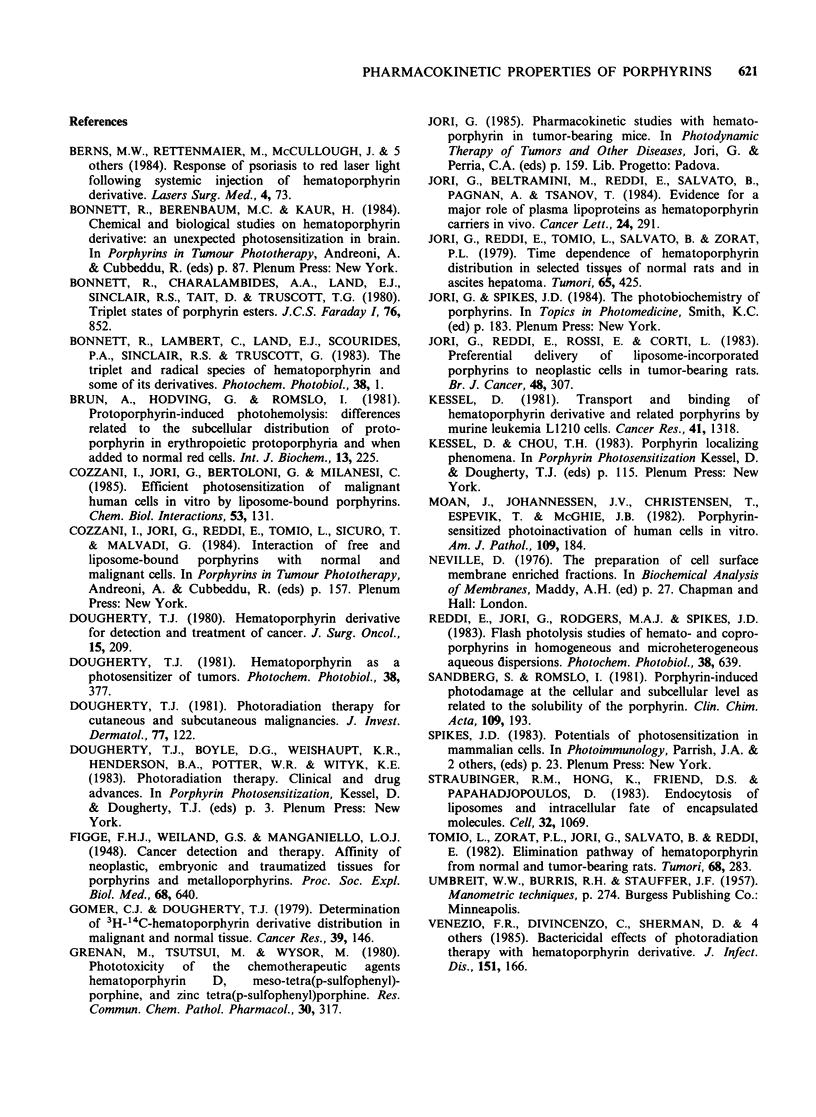
Selected References
These references are in PubMed. This may not be the complete list of references from this article.
- Bonnett R., Lambert C., Land E. J., Scourides P. A., Sinclair R. S., Truscott T. G. The triplet and radical species of haematoporphyrin and some of its derivatives. Photochem Photobiol. 1983 Jul;38(1):1–8. doi: 10.1111/j.1751-1097.1983.tb08358.x. [DOI] [PubMed] [Google Scholar]
- Brun A., Høvding G., Romslo I. Protoporphyrin-induced photohemolysis: differences related to the subcellular distribution of protoporphyrin in erythropoietic protoporphyria and when added to normal red cells. Int J Biochem. 1981;13(2):225–228. doi: 10.1016/0020-711x(81)90160-9. [DOI] [PubMed] [Google Scholar]
- Cozzani I., Jori G., Bertoloni G., Milanesi C., Carlini P., Sicuro T., Ruschi A. Efficient photosensitization of malignant human cells in vitro by liposome-bound porphyrins. Chem Biol Interact. 1985 Feb-Apr;53(1-2):131–143. doi: 10.1016/s0009-2797(85)80091-0. [DOI] [PubMed] [Google Scholar]
- Dougherty T. J. Hematoporphyrin as a photosensitizer of tumors. Photochem Photobiol. 1983 Sep;38(3):377–379. doi: 10.1111/j.1751-1097.1983.tb02687.x. [DOI] [PubMed] [Google Scholar]
- Dougherty T. J. Hematoporphyrin derivative for detection and treatment of cancer. J Surg Oncol. 1980;15(3):209–210. doi: 10.1002/jso.2930150303. [DOI] [PubMed] [Google Scholar]
- Dougherty T. J. Photoradiation therapy for cutaneous and subcutaneous malignancies. J Invest Dermatol. 1981 Jul;77(1):122–124. doi: 10.1111/1523-1747.ep12479341. [DOI] [PubMed] [Google Scholar]
- Gomer C. J., Dougherty T. J. Determination of [3H]- and [14C]hematoporphyrin derivative distribution in malignant and normal tissue. Cancer Res. 1979 Jan;39(1):146–151. [PubMed] [Google Scholar]
- Grenan M., Tsutsui M., Wysor M. Phototoxicity of the chemotherapeutic agents hematoporphyrin D, meso-tetra(p-sulfophenyl)porphine and zinc-tetra(p-sulfophenyl)porphine. Res Commun Chem Pathol Pharmacol. 1980 Nov;30(2):317–327. [PubMed] [Google Scholar]
- Jori G., Beltramini M., Reddi E., Salvato B., Pagnan A., Ziron L., Tomio L., Tsanov T. Evidence for a major role of plasma lipoproteins as hematoporphyrin carriers in vivo. Cancer Lett. 1984 Oct;24(3):291–297. doi: 10.1016/0304-3835(84)90025-9. [DOI] [PubMed] [Google Scholar]
- Jori G., Pizzi G., Reddi E., Tomio L., Salvato B., Zorat P., Calzavara F. Time dependence of hematoporphyrin distribution in selected tissues of normal rats and in ascites hepatoma. Tumori. 1979 Aug 31;65(4):425–434. doi: 10.1177/030089167906500402. [DOI] [PubMed] [Google Scholar]
- Jori G., Tomio L., Reddi E., Rossi E., Corti L., Zorat P. L., Calzavara F. Preferential delivery of liposome-incorporated porphyrins to neoplastic cells in tumour-bearing rats. Br J Cancer. 1983 Aug;48(2):307–309. doi: 10.1038/bjc.1983.186. [DOI] [PMC free article] [PubMed] [Google Scholar]
- Kessel D. Transport and binding of hematoporphyrin derivative and related porphyrins by murine leukemia L1210 cells. Cancer Res. 1981 Apr;41(4):1318–1323. [PubMed] [Google Scholar]
- Moan J., Johannessen J. V., Christensen T., Espevik T., McGhie J. B. Porphyrin-sensitized photoinactivation of human cells in vitro. Am J Pathol. 1982 Nov;109(2):184–192. [PMC free article] [PubMed] [Google Scholar]
- Sandberg S., Romslo I. Porphyrin-induced photodamage at the cellular and the subcellular level as related to the solubility of the porphyrin. Clin Chim Acta. 1981 Jan 22;109(2):193–201. doi: 10.1016/0009-8981(81)90334-x. [DOI] [PubMed] [Google Scholar]
- Straubinger R. M., Hong K., Friend D. S., Papahadjopoulos D. Endocytosis of liposomes and intracellular fate of encapsulated molecules: encounter with a low pH compartment after internalization in coated vesicles. Cell. 1983 Apr;32(4):1069–1079. doi: 10.1016/0092-8674(83)90291-x. [DOI] [PubMed] [Google Scholar]
- Tomio L., Zorat P. L., Jori G., Reddi E., Salvato B., Corti L., Calzavara F. Elimination pathway of hematoporphyrin from normal and tumor-bearing rats. Tumori. 1982 Aug;68(4):283–286. doi: 10.1177/030089168206800402. [DOI] [PubMed] [Google Scholar]
- Venezio F. R., DiVincenzo C., Sherman R., Reichman M., Origitano T. C., Thompson K., Reichman O. H. Bactericidal effects of photoradiation therapy with hematoporphyrin derivative. J Infect Dis. 1985 Jan;151(1):166–169. doi: 10.1093/infdis/151.1.166. [DOI] [PubMed] [Google Scholar]


